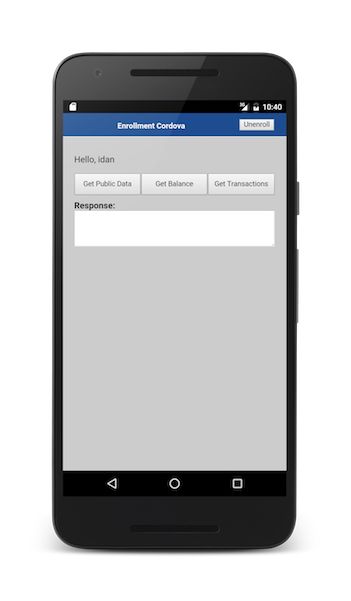注册
improve this page | report issue
概述
该样本演示了定制注册流程和递增授权。 在此一次性注册流程中,用户需要输入其用户名和密码,还需要定义 PIN 码。
先决条件:确保阅读 ExternalizableSecurityCheck 和递增教程。
跳转至:
应用程序流
- 在应用程序初次启动时(注册前),会显示具有以下两个按钮的 UI:获取公共数据和注册。
- 在用户点击注册按钮开始注册时,会使用登录表单进行提示,然后请求该用户设置 PIN 码。
- 在用户成功注册后,UI 包含四个按钮:获取公共数据、获取余额、获取交易和注销。 用户无需输入 PIN 码,便可访问全部四个按钮。
- 再次启动应用程序时(注册后),UI 仍包含所有四个按钮。 然而,当用户单击获取交易* 按钮时,会要求该用户输入 PIN 码。
尝试输入 PIN 码三次失败后,会提示该用户使用用户名和密码重新认证和重置 PIN 码。
将数据存储在持久性属性中
您可以选择将受保护数据保存在 PersistentAttributes 对象中,此对象是已注册客户机的定制属性的容器。 可以从安全性检查类或从适配器资源类访问该对象。
在提供的样本应用程序中,在适配器资源类中使用 PersistentAttributes 对象来存储 PIN 码:
-
setPinCode 资源可添加 pinCode 属性,并调用
AdapterSecurityContext.storeClientRegistrationData()方法来存储更改。@POST @OAuthSecurity(scope = "setPinCode") @Path("/setPinCode/{pinCode}") public Response setPinCode(@PathParam("pinCode") String pinCode){ ClientData clientData = adapterSecurityContext.getClientRegistrationData(); clientData.getProtectedAttributes().put("pinCode", pinCode); adapterSecurityContext.storeClientRegistrationData(clientData); return Response.ok().build(); }此处,
users具有一个名为EnrollmentUserLogin的键,其本身包含AuthenticatedUser对象。 -
unenroll 资源可删除 pinCode 属性,并调用
AdapterSecurityContext.storeClientRegistrationData()方法来存储更改。@DELETE @OAuthSecurity(scope = "unenroll") @Path("/unenroll") public Response unenroll(){ ClientData clientData = adapterSecurityContext.getClientRegistrationData(); if (clientData.getProtectedAttributes().get("pinCode") != null){ clientData.getProtectedAttributes().delete("pinCode"); adapterSecurityContext.storeClientRegistrationData(clientData); } return Response.ok().build(); }
安全性检查
注册样本包含三项安全性检查:
EnrollmentUserLogin
EnrollmentUserLogin 安全性检查保护 setPinCode 资源,以便只有已认证的用户才能够设置 PIN 码。 此安全性检查意味着快速到期,并且仅在“初次体验”期间进行。 它与实现 UserAuthenticationSecurityCheck 教程中所解释的 UserLogin 安全性检查相同, 但额外的 isLoggedIn 和 getRegisteredUser 方法除外。
如果安全性检查状态等于 SUCCESS,isLoggedIn 方法会返回 true,否则将返回 false。
getRegisteredUser 方法会返回已认证的用户。
public boolean isLoggedIn(){
return getState().equals(STATE_SUCCESS);
}
public AuthenticatedUser getRegisteredUser() {
return registrationContext.getRegisteredUser();
}
EnrollmentPinCode
EnrollmentPinCode 安全性检查可保护获取交易资源,与实现 CredentialsValidationSecurityCheck 教程中所解释的 PinCodeAttempts 安全性检查相似(一些更改除外)。
在本教程的示例中,EnrollmentPinCode 取决于 EnrollmentUserLogin。 成功登录到 EnrollmentUserLogin 后,只会要求用户输入 PIN 码。
@SecurityCheckReference
private transient EnrollmentUserLogin userLogin;
在应用程序初次启动且用户成功注册时,用户必须能够在无需输入其刚刚设置的 PIN 码的情况下访问获取交易资源。 为此,authorize 方法使用 EnrollmentUserLogin.isLoggedIn 方法来检查用户是否登录。 这意味着只要 EnrollmentUserLogin 不到期,用户便能够访问获取交易。
@Override
public void authorize(Set<String> scope, Map<String, Object> credentials, HttpServletRequest request, AuthorizationResponse response) {
if (userLogin.isLoggedIn()){
setState(STATE_SUCCESS);
response.addSuccess(scope, userLogin.getExpiresAt(), getName());
}
}
本教程针对用户尝试三次后输入 PIN 码失败的情况而设计,以便在提示用户使用用户名和密码并重置 PIN 码进行认证之前,先删除 pinCode 属性。
@Override
public void authorize(Set<String> scope, Map<String, Object> credentials, HttpServletRequest request, AuthorizationResponse response) {
PersistentAttributes attributes = registrationContext.getRegisteredProtectedAttributes();
if (userLogin.isLoggedIn()){
setState(STATE_SUCCESS);
response.addSuccess(scope, userLogin.getExpiresAt(), getName());
} else {
super.authorize(scope, credentials, request, response);
if (getState().equals(STATE_BLOCKED)){
attributes.delete("pinCode");
}
}
}
validateCredentials 方法与在 PinCodeAttempts 安全性检查中相同,只是此处会将凭证与存储的 pinCode 属性进行比较。
@Override
protected boolean validateCredentials(Map<String, Object> credentials) {
PersistentAttributes attributes = registrationContext.getRegisteredProtectedAttributes();
if(credentials!=null && credentials.containsKey("pin")){
String pinCode = credentials.get("pin").toString();
if(pinCode.equals(attributes.get("pinCode"))){
errorMsg = null;
return true;
}
else {
errorMsg = "The pin code is not valid. Hint: " + attributes.get("pinCode");
}
}
else{
errorMsg = "The pin code was not provided.";
}
//In any other case, credentials are not valid
return false;
}
IsEnrolled
IsEnrolled 安全性检查可保护:
- getBalance 资源,以便只有注册用户才能看到余额。
- transactions 资源,以便只有注册用户才能获取交易。
- unenroll 资源,以便只有在先前设置了 pinCode 的情况下才能将其删除。
创建安全性检查
创建 Java 适配器,并添加名为 IsEnrolled 且可扩展 ExternalizableSecurityCheck 的 Java 类。
public class IsEnrolled extends ExternalizableSecurityCheck{
protected void initStateDurations(Map<String, Integer> durations) {}
public void authorize(Set<String> scope, Map<String, Object> credentials, HttpServletRequest request, AuthorizationResponse response) {}
public void introspect(Set<String> scope, IntrospectionResponse response) {}
}
IsEnrolledConfig 配置类
创建可扩展 ExternalizableSecurityCheckConfig 的 IsEnrolledConfig 配置类:
public class IsEnrolledConfig extends ExternalizableSecurityCheckConfig {
public int successStateExpirationSec;
public IsEnrolledConfig(Properties properties) {
super(properties);
successStateExpirationSec = getIntProperty("expirationInSec", properties, 8000);
}
}
将 createConfiguration 方法添加到 IsEnrolled 类中:
public class IsEnrolled extends ExternalizableSecurityCheck{
@Override
public SecurityCheckConfiguration createConfiguration(Properties properties) {
return new IsEnrolledConfig(properties);
}
}
initStateDurations 方法
将 SUCCESS 状态的持续时间设置为 successStateExpirationSec:
@Override
protected void initStateDurations(Map<String, Integer> durations) {
durations.put (SUCCESS_STATE, ((IsEnrolledConfig) config).successStateExpirationSec);
}
authorize 方法
代码样本仅检查用户是否注册,并相应地返回成功或失败:
public void authorize(Set<String> scope, Map<String, Object> credentials, HttpServletRequest request, AuthorizationResponse response) {
PersistentAttributes attributes = registrationContext.getRegisteredProtectedAttributes();
if (attributes.get("pinCode") != null){
setState(SUCCESS_STATE);
response.addSuccess(scope, getExpiresAt(), this.getName());
} else {
setState(STATE_EXPIRED);
Map <String, Object> failure = new HashMap<String, Object>();
failure.put("failure", "User is not enrolled");
response.addFailure(getName(), failure);
}
}
-
如果存在
pinCode属性: - 请使用
setState方法将状态设置为 SUCCESS。 -
请使用
addSuccess方法将成功添加到响应对象中。 -
如果
pinCode属性不存在: - 请使用
setState方法将状态设置为 EXPIRED。 - 请使用
addFailure方法将失败添加到响应对象中。
IsEnrolled 安全性检查取决于 EnrollmentUserLogin:
@SecurityCheckReference
private transient EnrollmentUserLogin userLogin;
通过添加以下代码来设置活动用户:
public void authorize(Set<String> scope, Map<String, Object> credentials, HttpServletRequest request, AuthorizationResponse response) {
PersistentAttributes attributes = registrationContext.getRegisteredProtectedAttributes();
if (attributes.get("pinCode") != null){
// Is there a user currently active?
if (!userLogin.isLoggedIn()){
// If not, set one here.
authorizationContext.setActiveUser(userLogin.getRegisteredUser());
}
setState(SUCCESS_STATE);
response.addSuccess(scope, getExpiresAt(), this.getName());
} else {
setState(STATE_EXPIRED);
Map <String, Object> failure = new HashMap<String, Object>();
failure.put("failure", "User is not enrolled");
response.addFailure(getName(), failure);
}
}
然后,transactions 资源可获取当前的 AuthenticatedUser 对象来呈现显示名称:
@GET
@Produces(MediaType.TEXT_PLAIN)
@OAuthSecurity(scope = "transactions")
@Path("/transactions")
public String getTransactions(){
AuthenticatedUser currentUser = securityContext.getAuthenticatedUser();
return "Transactions for " + currentUser.getDisplayName() + ":\n{'date':'12/01/2016', 'amount':'19938.80'}";
}
有关
securityContext的更多信息,请参阅 Java 适配器教程中的安全性 API 部分。
通过添加以下内容,将注册用户添加到响应对象中:
public void authorize(Set<String> scope, Map<String, Object> credentials, HttpServletRequest request, AuthorizationResponse response) {
PersistentAttributes attributes = registrationContext.getRegisteredProtectedAttributes();
if (attributes.get("pinCode") != null){
// Is there a user currently active?
if (!userLogin.isLoggedIn()){
// If not, set one here.
authorizationContext.setActiveUser(userLogin.getRegisteredUser());
}
setState(SUCCESS_STATE);
response.addSuccess(scope, getExpiresAt(), getName(), "user", userLogin.getRegisteredUser());
} else {
setState(STATE_EXPIRED);
Map <String, Object> failure = new HashMap<String, Object>();
failure.put("failure", "User is not enrolled");
response.addFailure(getName(), failure);
}
}
在样本代码中,IsEnrolled 验证问题处理程序的 handleSuccess 方法使用用户对象来呈现显示名称。

样本应用程序
安全性检查
注册 Maven 项目下的 SecurityChecks 项目中提供了 EnrollmentUserLogin、EnrollmentPinCode 和 IsEnrolled 安全性检查。
单击以下载安全性检查 Maven 项目。
应用程序
样本应用程序可用于 iOS (Swift)、Android、Cordova 和 Web。
样本用法
请遵循样本的 README.md 文件获取指示信息。
▲Inclusive terminology note: The Mobile First Platform team is making changes to support the IBM® initiative to replace racially biased and other discriminatory language in our code and content with more inclusive language. While IBM values the use of inclusive language, terms that are outside of IBM's direct influence are sometimes required for the sake of maintaining user understanding. As other industry leaders join IBM in embracing the use of inclusive language, IBM will continue to update the documentation to reflect those changes.